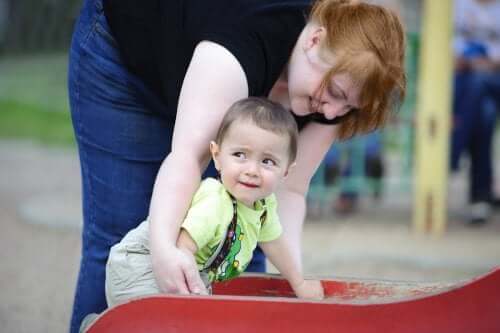Insecure Attachment: Characteristics and Consequences


Written and verified by the psychologist María Alejandra Castro Arbeláez
There are multiple studies that relate insecure attachment to dysfunctional behavior, at any stage of life. According to Bowlby (1958), babies need to be close to certain people who provide the necessary tools of survival. At least, until they’re able to fend for themselves.
As a result of the closeness and control that babies have over these individuals, the bond of attachment is produced. A person establishes an attachment when they seek contact with an individual who is best trained to protect them, especially in situations of insecurity.
“The response of fear in a person that is provoked by inaccessibility to a mother is a basic adaptation reaction. In the course of evolution, that has become an essential response for the contribution of the survival of the species.”
–Bowlby–
Creation of the bond of attachment
The way in which we establish the bond of attachment is regulated throughout our lives. It varies based on our experiences. However, the most critical period is childhood, the stage that we form our beliefs about:
- Our own self-concept
- How our attachment figures are
- What we expect or think we deserve from others

These systems favor the approach to the referenced figure, while activating unpleasant responses before separation. Oxytocin, prolactin, and endorphins regulate this process.
Moriceau and Sullivan (2005) concluded that attachment results from the activation and structural modification of the olfactory bulb. This way, the nervous system adapts to the child’s current environment. This is possibly due to:
- The postnatal development of noradrenergic projections from the locus coeruleus (McLean and Shipley, 1991).
- The immaturity of the amygdala and the hypothalamic-pituitary-adrenal axis (Jakubs and Sullivan, 2009).
“The type of attachment will depend on the availability, the receptivity, and the warmth of the mother as well as the established connection.”
–Bottle, 2005–
Consequences of insecure attachment
Insecure attachment affects people whose parents have:
- Not been emotionally available.
- Ignored their children’s cries for help.
- Been unable to meet the needs of their children.
- Established chaotic and unstable relationships with their children.
Within this profile, and due to the deficiencies the children suffer, they try to adapt to these situations. Depending on the tools they received as infants, two types of attachment may occur:
- Insecure-avoidant attachment: Children will minimize the search of their caregivers. They’ve learned that they can’t depend on anyone and as a result, they must be self-sufficient.
- Anxious insecure attachment: Children are ambivalent and incessantly search for the attention of other people. Since relationships have become unpredictable, they don’t understand what to do.
Both types of attachment can have serious consequences, such as:
- Psychological and personality disorders: depression, obsessive-compulsive disorder, borderline disorder, etc.
- Addictive behaviors
- Emotional imbalances
- Negative perfectionism and feelings of incompetence
- Suicide
Characteristics of insecure-avoidant attachment
- Analytical thinking, avoiding emotional involvement.
- Apparent disinterest in relationships with others.
- Shyness and individualistic tendencies.

- Avoidance of situations that entail a certain degree of intimacy.
- Possible difficulty in controlling aggression resulting in explosions of anger and rage.
- Possible disorganization in day-to-day life.
- In the childhood stage, it may go unnoticed in a school setting and not result in academic problems. During adolescence, it can significantly lower academic performance.
Characteristics of anxious insecure attachment
- Continuous calls for attention through disruptive behavior or emotional blackmail.
- Idealization of others. Although, if children feel frustrated because their needs haven’t been met, they may start to devalue people they once admired.
- Obsessive concern to know what significant figures in their lives admire, want, or need.
- Emotional ambivalence and symptoms of anxiety.
- Learning or attention control problems.
- Tendency to ignore the needs of others, focusing only on their own.
- Difficulty to assume guilt, holding others responsible; recurring tendency to distort certain situations.
There are multiple studies that relate insecure attachment to dysfunctional behavior, at any stage of life. According to Bowlby (1958), babies need to be close to certain people who provide the necessary tools of survival. At least, until they’re able to fend for themselves.
As a result of the closeness and control that babies have over these individuals, the bond of attachment is produced. A person establishes an attachment when they seek contact with an individual who is best trained to protect them, especially in situations of insecurity.
“The response of fear in a person that is provoked by inaccessibility to a mother is a basic adaptation reaction. In the course of evolution, that has become an essential response for the contribution of the survival of the species.”
–Bowlby–
Creation of the bond of attachment
The way in which we establish the bond of attachment is regulated throughout our lives. It varies based on our experiences. However, the most critical period is childhood, the stage that we form our beliefs about:
- Our own self-concept
- How our attachment figures are
- What we expect or think we deserve from others

These systems favor the approach to the referenced figure, while activating unpleasant responses before separation. Oxytocin, prolactin, and endorphins regulate this process.
Moriceau and Sullivan (2005) concluded that attachment results from the activation and structural modification of the olfactory bulb. This way, the nervous system adapts to the child’s current environment. This is possibly due to:
- The postnatal development of noradrenergic projections from the locus coeruleus (McLean and Shipley, 1991).
- The immaturity of the amygdala and the hypothalamic-pituitary-adrenal axis (Jakubs and Sullivan, 2009).
“The type of attachment will depend on the availability, the receptivity, and the warmth of the mother as well as the established connection.”
–Bottle, 2005–
Consequences of insecure attachment
Insecure attachment affects people whose parents have:
- Not been emotionally available.
- Ignored their children’s cries for help.
- Been unable to meet the needs of their children.
- Established chaotic and unstable relationships with their children.
Within this profile, and due to the deficiencies the children suffer, they try to adapt to these situations. Depending on the tools they received as infants, two types of attachment may occur:
- Insecure-avoidant attachment: Children will minimize the search of their caregivers. They’ve learned that they can’t depend on anyone and as a result, they must be self-sufficient.
- Anxious insecure attachment: Children are ambivalent and incessantly search for the attention of other people. Since relationships have become unpredictable, they don’t understand what to do.
Both types of attachment can have serious consequences, such as:
- Psychological and personality disorders: depression, obsessive-compulsive disorder, borderline disorder, etc.
- Addictive behaviors
- Emotional imbalances
- Negative perfectionism and feelings of incompetence
- Suicide
Characteristics of insecure-avoidant attachment
- Analytical thinking, avoiding emotional involvement.
- Apparent disinterest in relationships with others.
- Shyness and individualistic tendencies.

- Avoidance of situations that entail a certain degree of intimacy.
- Possible difficulty in controlling aggression resulting in explosions of anger and rage.
- Possible disorganization in day-to-day life.
- In the childhood stage, it may go unnoticed in a school setting and not result in academic problems. During adolescence, it can significantly lower academic performance.
Characteristics of anxious insecure attachment
- Continuous calls for attention through disruptive behavior or emotional blackmail.
- Idealization of others. Although, if children feel frustrated because their needs haven’t been met, they may start to devalue people they once admired.
- Obsessive concern to know what significant figures in their lives admire, want, or need.
- Emotional ambivalence and symptoms of anxiety.
- Learning or attention control problems.
- Tendency to ignore the needs of others, focusing only on their own.
- Difficulty to assume guilt, holding others responsible; recurring tendency to distort certain situations.
All cited sources were thoroughly reviewed by our team to ensure their quality, reliability, currency, and validity. The bibliography of this article was considered reliable and of academic or scientific accuracy.
- Barg Beltrame, Gabriel. (2011). Bases neurológicas del desarrollo. Ciencias Psicológicas, 5(1), 69-81. Recuperado en 20 de abril de 2019.
- Gonzalo Marrodan, JL. (2009). Guía para el apoyo educativo de niños con trastorno de apego. Ed: Libros Ted.
- Guzmán-González, Mónica, Carrasco, Natalia, Figueroa, Paulina, Trabucco, Caterina, & Vilca, Daniela. (2016). Estilos de Apego y Dificultades de Regulación Emocional en Estudiantes. Psykhe (Santiago), 25(1), 1-13.
- Marrone, M. (2001). La teoría del apego. Un enfoque actual. (2º ed. 2009). Madrid: Psimática.
- Siegel, D. J. (2007) La mente en desarrollo. Cómo interactúan las relaciones y el cerebro para modelar nuestro ser. Bilbao, Desclée de Brouwer.
This text is provided for informational purposes only and does not replace consultation with a professional. If in doubt, consult your specialist.








